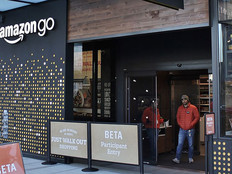6 Infrastructure Elements Retailers Need to Support Digital Transformation
Many retailers opt not to make large-scale IT infrastructure changes all at once. Instead, they take a wait-and-see approach to new technologies, implementing them as new needs arise. It makes sense not to spend large sums on unproven solutions, but there is one area where retailers should absolutely invest with an eye on the future: IT infrastructure.
When retailers lack the back-end resources to support new technologies, they can find themselves falling behind their competitors, with then-necessary rip-and-replace efforts slowing future progress and increasing the cost of new initiatives. In IT infrastructure planning, retailers should not only consider the technologies they plan to deploy within the next nine to 12 months, but also attempt to anticipate their needs up to five years down the road.
While retail IT leaders might not be able to say with certainty which specific applications they’ll be rolling out in half a decade, it’s all but certain that demands on infrastructure will continue to rise, and it’s important for organizations to position themselves to adapt rapidly to a changing environment.
Although new use cases will continue to pop up, the business goals driving the need for IT investments — such as increased customer engagement — will largely remain constant. These are the business drivers that should inform the design and deployment of retail technology solutions. Smart retail is a big-picture approach that identifies not only critical business problems, but also opportunities to improve decision-making and operations through better data. The best technology solutions work to achieve both of these goals in tandem, solving problems while empowering retailers for continuous data-driven improvement. For instance, CDW offers configurable building blocks within specific solution domains, such as point of sale and network infrastructure. These building blocks can be bundled to help retailers solve their unique business problems.
Investments in the following areas can help stores implement smart retail solutions today while preparing for a changing future.
SIGN UP: Get more news from the BizTech newsletter in your inbox every two weeks!
1. Robust Networks Help Retailers Process Data
The rise of mobility in recent years has heightened the importance of robust networking solutions, and emerging technologies such as the Internet of Things (IoT) will only deepen retailers’ reliance on their networks. In addition to wireless technologies such as access points and mobile beacons, many stores are beefing up their investments in areas such as WAN/LAN, telecommunications and software-defined networking.
As data analytics use cases become more prevalent, it is the network that will ensure retailers are able to accommodate information from customer-facing mobile apps, inventory systems, smart cameras and other IoT endpoints.
2. Hybrid Cloud and Hyperconvergence Aid in Data Storage
The data center, along with cloud solutions, will play an enormous role in data analytics initiatives, which require retailers to store and process more information than ever before. As stores grow their capacity, retail executives will need to make decisions about which resources to keep on-premises and which to outsource to the cloud. For retail data analytics in particular, a hybrid cloud approach may make sense, as this allows stores to quickly scale resources up and down according to demand — an essential capability in an industry that sees dramatic seasonal spikes.
Increasingly, organizations are turning to hyperconvergence for the on-premises component of their hybrid clouds. Hyperconverged infrastructure combines compute, storage and networking into a single solution, mimicking the scalability benefits of the public cloud while letting organizations keep mission-critical applications and sensitive data in-house.
3. End-User Solutions Give Employees Access to Apps and Data
More of a near-term concern than backend retail IT infrastructure, end-user solutions can play a pivotal role in powering current data-centered initiatives and giving organizations the ability to test out new applications. These solutions include mobile point-of-sale (mPOS) devices, barcode scanners, smartphones and tablets. Retailers can use these devices to put both product and customer information at the fingertips of floor associates, which increases their value to shoppers and mitigates an existing pain point.
According to Salesforce Research, half of millennials believe they typically know more about a store than store associates do, and 43 percent believe robots could effectively replace store associates. These are worrying numbers in an industry where customer service is rapidly becoming a key competitive differentiator. Mobile apps that instill employees with more information can help. Retailers should also ensure their corporate staff have the collaboration and communication tools they need to be effective, including up-to-date desktops, voice/phone solutions and videoconferencing tools.
4. Micro Data Centers Support IT at Branch Locations
By nature, retail organizations are spread across multiple locations, and this distributed geography can create challenges for IT infrastructure. It is often advantageous to locate technology resources at each individual store, but in the past, this has created problems tied to both security and management. Individual stores typically do not have an IT staffer onsite, so it has been difficult for IT shops in retail organizations to keep a handle on in-store resources and respond quickly when trouble arises.
A number of organizations are solving this problem with micro data centers — self-contained solutions that provide not only essential infrastructure, but also physical security, power and cooling, and remote management capabilities.
5. Security Tools Can Mitigate the Damage of DataBreachess
Nothing torpedoes customer trust as quickly as a data breach. As retailers build out systems to collect and analyze more information, they must implement robust systems to keep that information out of the hands of malicious actors. Security investments may include tools such as identity and access management, next-generation firewalls, physical security and incident response systems.
Onsite assessments and testing can help retail IT leaders identify gaps in their cybersecurity strategies, and security monitoring can help retailers ensure that systems are working as designed. Organizations must also look beyond prevention. No cybersecurity plan can guarantee that a breach won’t occur, and retailers should have detailed incident response plans to help them recognize an attack and mitigate damage.
6. Support Solutions Help Smooth IT Adoption
New IT infrastructure requires additional support, which can strain overburdened IT shops.
Often, retailers turn to a trusted partner to assist with provisioning and deploying resources, managing infrastructure over time and providing help desk support.
Learn how to craft a smarter retail strategy by reading the CDW white paper, "Smart Retail Powers Data-Driven Insights."








